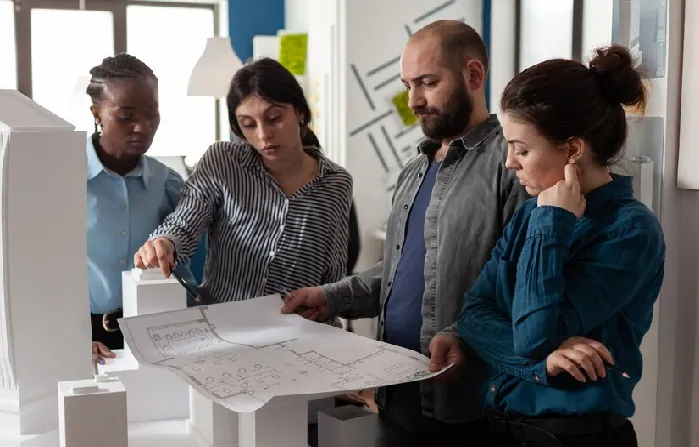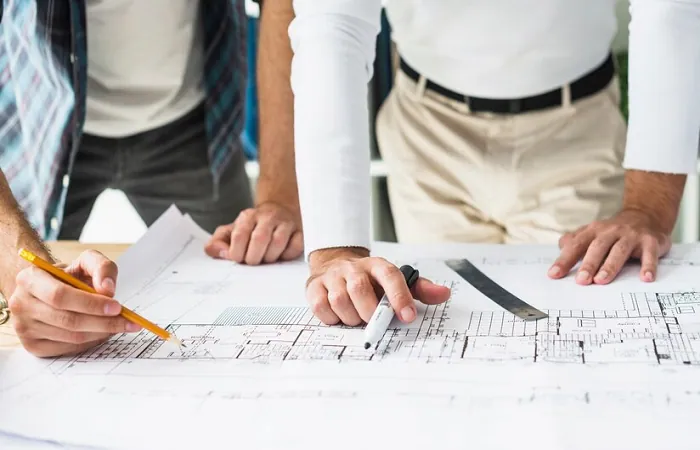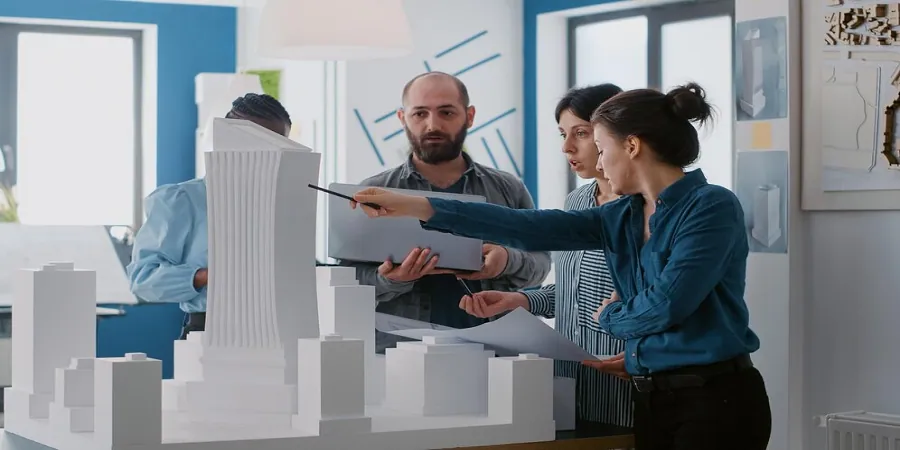The Role of Architects in Shaping Spaces
Architects play a crucial role in shaping the spaces where we live, work, and play. They are the creative minds behind the buildings and environments that surround us. By blending art and science, architects design structures that are not only functional but also aesthetically pleasing. They consider every detail, from how a space will be used to how it will look and feel. Their expertise goes beyond just drawing blueprints; they think about how light enters a room, how spaces connect, and how materials will age over time.
The Importance of Choosing the Right Architect
Choosing the right architect is essential when you want to turn your dreams into reality. The right architect will listen to your ideas, understand your needs, and translate them into a design that fits your lifestyle and preferences. They will guide you through the entire process, from the initial concept to the finished building, ensuring that your vision is realized in the best way possible. Working with an experienced and skilled architect can make a huge difference in the success of your project.
Purpose of the Post
The purpose of this post is to guide you through the architectural design process. Whether you’re planning to build a new home, renovate an existing space, or create a commercial building, understanding the role of architects and the steps involved in design can help you make informed decisions. This post will take you through the key stages of working with an architect, from the initial consultation to the final construction, providing insights and tips to ensure your project is a success.
Understanding the Architect's Role

Overview of What Architects Do: From Concept to Completion
Architects are responsible for designing buildings and spaces that meet the needs and desires of their clients. Their role extends from the very beginning of a project to its completion. At the concept stage, architects listen to your ideas and gather information about your goals, budget, and the specific requirements of the project. They then create initial sketches and designs, which evolve into detailed plans as the project progresses. Architects also work closely with contractors, engineers, and other professionals to ensure that the design is built correctly and safely. Their job doesn’t end when the design is finalized; they often oversee the construction process to ensure everything goes according to plan.
How Architects Translate Client Visions into Functional Designs
One of the most important aspects of an architect’s job is translating a client’s vision into a functional and aesthetically pleasing design. This requires a deep understanding of both design principles and practical considerations. Architects take your ideas and needs and turn them into a workable plan. For example, if you dream of a spacious, light-filled home, the architect will consider how to position windows, plan open spaces, and use materials that enhance natural light. They balance creativity with practicality, making sure that the design not only looks good but also works well in everyday life.
Importance of Collaboration Between the Architect and Client
Collaboration between the architect and client is key to a successful project. Good communication ensures that the architect fully understands your vision and that you are comfortable with the direction of the design. Regular meetings and updates allow for adjustments to be made along the way, ensuring that the final result meets your expectations. The more engaged you are in the process, the more likely you’ll end up with a space that truly reflects your desires. A strong partnership with your architect can make the entire experience smoother and more enjoyable.
The Architectural Design Process

Initial Consultation and Planning
The architectural design process begins with an initial consultation between the architect and the client. During this phase, the architect discusses the client’s needs, goals, and budget. This conversation helps the architect understand what the client wants to achieve with the project. Additionally, the architect conducts a site analysis, evaluating the location where the project will be built. They also carry out feasibility studies to determine if the project is viable, considering factors like the site’s conditions, zoning laws, and environmental impact.
Conceptual Design
Once the initial planning is complete, the architect moves on to the conceptual design phase. This is where creativity comes into play. The architect brainstorms ideas and begins sketching rough designs. These sketches are transformed into initial design concepts and models that give the client a visual representation of the project. During this stage, the architect presents these concepts to the client, who can provide feedback and request changes. This collaborative process ensures that the design aligns with the client’s vision.
Design Development
After the conceptual design is approved, the project enters the design development phase. Here, the architect refines the initial design, creating detailed plans and selecting materials. The focus is on improving the design’s functionality, ensuring it meets the client’s practical needs while also considering aesthetics. Sustainability is also a key consideration during this phase, with architects choosing materials and design features that are environmentally friendly and energy-efficient.
Finalizing the Design
The final phase of the architectural design process involves creating detailed blueprints and construction documents. These documents guide the construction team in building the project. The architect ensures that the design complies with all relevant regulations and building codes, securing any necessary permits. At this stage, the design is finalized, and the project is ready to move into the construction phase, bringing the client’s vision to life.
Finding the Right Architect

Tips on Researching and Selecting an Architect
Finding the right architect is crucial for bringing your design dreams to life. Start by researching architects in your area or those who specialize in the type of project you’re planning. You can ask for recommendations from friends, family, or colleagues who have worked with architects before. Online searches and professional directories can also help you find qualified architects. Look for architects who are licensed and have experience in projects similar to yours. Don’t rush this process—finding the right match is key to a successful project.
Importance of Reviewing Portfolios and Past Projects
Before making a decision, it’s important to review an architect’s portfolio. A portfolio showcases the architect’s previous work and gives you a sense of their style and capabilities. Look for projects that are similar in scope and style to what you’re envisioning. This will help you determine if the architect has the experience and creativity needed to handle your project. Pay attention to the quality of work, the use of space, and how well the architect’s designs align with your taste. If possible, visit some of the architect’s completed projects in person to see the quality of their work up close.
Questions to Ask During the Selection Process
When you’ve narrowed down your list of potential architects, it’s time to meet with them. During these meetings, ask important questions to ensure they are the right fit for your project. Some key questions include:
- How do you approach design challenges?
- Can you provide references from past clients?
- What is your experience with projects of this size and scope?
- How do you handle project timelines and budgets?
- What is your process for incorporating client feedback into the design?
These questions will help you understand the architect’s working style, communication skills, and ability to meet your expectations. Selecting the right architect ensures a smoother design process and a final result that matches your vision.
Collaborating with Your Architect

Importance of Clear Communication Throughout the Project
Clear communication is the foundation of a successful collaboration with your architect. From the very beginning, it’s essential to express your ideas, needs, and expectations clearly. This ensures that your architect fully understands your vision and can create designs that align with your goals. Regular communication throughout the project is key. Whether it’s through meetings, phone calls, or emails, staying in touch helps keep everyone on the same page. If there are any changes or concerns, discussing them openly with your architect will help prevent misunderstandings and keep the project on track.
How to Provide Feedback and Make Informed Decisions
Your input is vital during the design process. Don’t hesitate to provide feedback on the architect’s ideas and designs. If something doesn’t feel right or if you have new ideas, share them with your architect. Remember, this is your project, and your satisfaction is the ultimate goal. When making decisions, it’s important to consider the architect’s professional advice. Architects have the expertise to guide you through choices regarding materials, layout, and functionality. Ask questions and weigh the pros and cons before making final decisions. Being informed allows you to make choices that best fit your vision and budget.
Building a Strong Client-Architect Relationship for Successful Outcomes
A strong relationship between you and your architect is crucial for a successful project. Trust and mutual respect are the cornerstones of this relationship. Trust your architect’s expertise and experience, and be open to their suggestions. At the same time, your architect should respect your vision and work to bring it to life. Building this relationship takes time, but it’s worth the effort. A strong client-architect relationship leads to a smoother process, fewer conflicts, and a final design that meets or exceeds your expectations. Working closely and collaboratively with your architect ensures that your dream project becomes a reality.
Bringing the Design to Life

The Construction Phase: From Design to Reality
The construction phase is when your architectural design begins to take physical form. After months of planning, sketching, and refining ideas, the project finally moves from paper to the real world. This phase involves various professionals, including builders, contractors, and suppliers, working together to bring the design to life. The process can be exciting but also challenging, as it involves coordinating multiple tasks, managing timelines, and ensuring that the work aligns with the original plans. This is the stage where all the planning and design efforts start to materialize into a tangible structure.
The Architect's Role During Construction: Oversight and Adjustments
Even though the primary design work is done, your architect still plays a crucial role during the construction phase. The architect’s responsibility includes overseeing the construction to ensure that it aligns with the design plans. They may visit the site regularly to monitor progress, address any issues that arise, and make sure that the project stays on track. Sometimes, unexpected challenges can occur during construction, such as material shortages or unforeseen site conditions. In such cases, the architect may need to make adjustments to the design. These changes are made carefully to maintain the integrity of the original vision while accommodating the realities of construction.
Ensuring the Final Project Meets the Original Vision
One of the architect’s key responsibilities during construction is to ensure that the final project meets the original vision. This involves close attention to detail, from the materials used to the finishes applied. The architect works closely with the builders to make sure that every aspect of the design is executed as planned. This includes everything from the overall structure to the smallest details like lighting and fixtures. By staying involved throughout the construction process, the architect helps ensure that the completed project not only looks as envisioned but also functions as intended, fulfilling your expectations and bringing your dream design to life.
The architectural journey, from concept to completion, is a transformative process that brings dream projects to life. Architects guide you through each step, ensuring that your vision is realized in every detail. Engaging with a skilled architect can turn your ideas into functional, beautiful spaces that enhance your quality of life. Thoughtful design has a profound impact, creating environments that are not only visually appealing but also tailored to your needs. Whether building a home or renovating a space, working with an architect can make your dream a reality, enriching your everyday life.

Comments